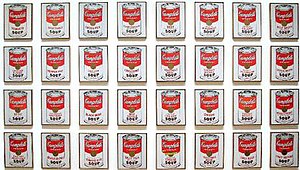Campbell's Soup Cans
| Campbell's Soup Cans | |
|---|---|
 |
|
| Artist | Andy Warhol |
| Year | 1962 |
| Medium | Synthetic polymer paint on canvas |
| Dimensions | 20 by 16 inches (51 cm × 41 cm) each for 32 canvases |
| Location |
Museum of Modern Art. Acquired through the Lillie P. Bliss Bequest, New York, NY (32 canvas series displayed by year of introduction) |
| Accession | 476.1996.1–32 |
|
|
Campbell's Soup Cans, which is sometimes referred to as 32 Campbell's Soup Cans, is a work of art produced in 1962 by Andy Warhol. It consists of thirty-two canvases, each measuring 20 inches (51 cm) in height × 16 inches (41 cm) in width and each consisting of a painting of a Campbell's Soup can—one of each of the canned soup varieties the company offered at the time. The individual paintings were produced by a printmaking method—the semi-mechanized screen printing process, using a non-painterly style. Campbell's Soup Cans' reliance on themes from popular culture helped to usher in pop art as a major art movement in the United States.
Warhol, a commercial illustrator who became a successful author, publisher, painter, and film director, showed the work on July 9, 1962, in his first one-man gallery exhibition as a fine artist in the Ferus Gallery of Los Angeles, California. The exhibition marked the West Coast debut of pop art. The combination of the semi-mechanized process, the non-painterly style, and the commercial subject initially caused offense, as the work's blatantly mundane commercialism represented a direct affront to the technique and philosophy of abstract expressionism. In the United States the abstract expressionism art movement was dominant during the post-war period, and it held not only to "fine art" values and aesthetics but also to a mystical inclination. This controversy led to a great deal of debate about the merits and ethics of such work. Warhol's motives as an artist were questioned, and they continue to be topical to this day. The large public commotion helped transform Warhol from being an accomplished 1950s commercial illustrator to a notable fine artist, and it helped distinguish him from other rising pop artists. Although commercial demand for his paintings was not immediate, Warhol's association with the subject led to his name becoming synonymous with the Campbell's Soup Can paintings.
...
Wikipedia
